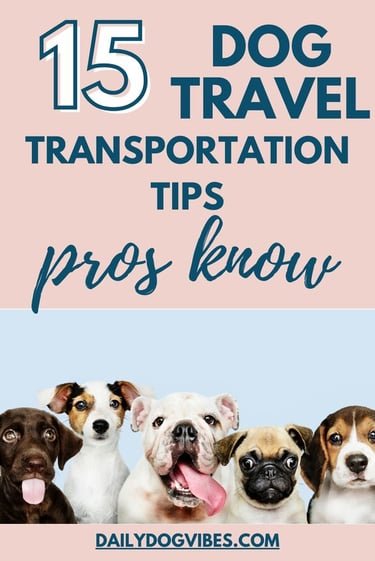35 Summer Dog Travel Safety Tips
Save these 35 top summer safety tips for dog-friendly travel this summer. Whether you are hitting the road or the great outdoors, keep these tips in mind.
SAFETY & WELLNESS
Katie Abendroth
4/18/2024
Summer Travel Series Part 3: Dog Travel Safety Tips
As you plan for Summer travel, save these tips to make sure everyone has a great vacation.
For highly sensitive people (HSPs) and empaths, traveling with your dog makes everything better. But keeping them safe is essential for a stress-less trip.
Whether you are planning road trips, camping, or even flying, buckle up, because I've got 35 summer travel tips to keep your emotional support animal or companion canine safe this summer.
Save for later!
Essential Safety Tips
ID Tags and Microchipping: Double-check that your dog's ID tags are securely attached to their collar and that their microchip information is up-to-date with your current contact details.
Pack Pet Essentials: Bring along your dog's food, water, bowls, doggy diapers, medications, leash, poop bags, and any comfort items like blankets or toys.
Pre-Trip Vet Check-Up: Before hitting the road, schedule a visit to the vet for a check-up for your furry friend. Ensure your pup is up-to-date on vaccinations and flea/tick preventatives. International trips may require health certificates within 10 days of travel, so be sure to check all air travel or cruise line requirements.
First Aid Kit: Prepare a first aid kit for your pup, including items like gauze, antiseptic wipes, tweezers (for tick removal), and any necessary medications prescribed by your vet.
Proper Restraint: Ensure your dog is safely restrained while in the car. Seat belt harnesses, travel crates, or pet barriers are the safest way to prevent distractions and ensure their safety in case of an accident. Dogs are safer in the back seat than the front seat, or in a travel crate in the cargo hold area in the event of an accident.
Test Drive: If your dog isn't used to car travel, take them on shorter drives leading up to your trip to help them acclimate and reduce anxiety.
Avoid Hot Cars: Never leave your dog unattended in a parked car, even for a few minutes. On a hot day, temperatures inside a car can skyrocket, leading to heatstroke and even death.
Hydration Station: Keep plenty of fresh water available for your dog during the trip. Offer frequent water breaks, especially during rest stops or outdoor activities. Store bottled water to have on hand in case your travel gets delayed. Signs of heatstroke in your four-legged friends include excessive panting, drooling, weakness, and vomiting. If you suspect heatstroke, seek veterinary care immediately in case of emergency.
Shade and Ventilation: When stopping for breaks, look for shaded areas to park your car and provide adequate ventilation to keep your dog cool and comfortable.
Sun Protection: Just like us, dogs can get sunburned, especially those with short coats or light-colored fur. Apply pet-safe sunscreen to exposed areas like their nose, ears, and belly.
Paws Protection: Hot pavement can burn your dog's paw pads. Walk them during cooler times of the day or invest in protective booties for extra paw pad insulation.
Tick and Flea Prevention: Check your dog for ticks regularly, especially after spending time outdoors. Use vet-approved flea and tick preventatives to keep these pests at bay.
Know the Route: Plan your travel route in advance, taking into account pet-friendly accommodations, rest areas, and dog parks along the way.
Keep Them Leashed: Always keep your dog on a leash when outside of the car, even if they're well-behaved. This prevents them from getting lost or wandering into dangerous areas. Also be sure to have a current id tag attached to your dog's collar; I love QR Code tags that allow you to scan pet owners contact information, microchip info, and health certificate.
Secure Open Windows: If your dog enjoys sticking their head out the window, make sure it's only open enough to prevent them from jumping out or getting injured by passing objects.
Stay Hygienic: Clean up after your dog at rest stops and campgrounds. Dispose of waste properly to keep the environment clean and sanitary for everyone. Keep hand sanitizer in your bag for a quick clean up.
Practice Recall: Work on your dog's recall commands before the trip, especially if you plan on letting them off-leash in designated areas.
Prevent Nausea: Practice short drives before longer trips so you can lean how your dog feels in a moving vehicle. Feed them a light meal before leaving but only provide water while you travel to prevent upset stomach. Unless there is cold weather, cracking the windows and running the A/C are a great way to keep fresh air circulating.
Plan for Pet-Friendly Attractions: Research pet-friendly activities and attractions at your destination to ensure your dog can join in on the fun. Check your hotel's pet policy in advance for breed restrictions, what vaccination records are required, and whether there is a limit on number of dogs you can have.
Prevent Pet Suffocation: It is always a good idea for pet parents to educate themselves on pet suffocation. Never leave your dog in the car with any food wrappers or chip bags; these can cause suffocation in less than 5 minutes. Always clear waste bags and food packaging when you arrive in a new place and exit your vehicle.
Emergency Contacts: Keep a list of emergency vet clinics along your route and at your destination, along with contact numbers for poison control and other essential services.
Create a Safe Space: If staying in a hotel or rental accommodation, designate a quiet and secure area where your dog can relax and feel at ease. Packing a foldable pet crate can keep your dog secure in unfamiliar spaces.
Avoid Open Truck Beds: Never allow your dog to ride in the back of an open truck bed. They could be injured by sudden stops, debris, or jumping out.
Watch What They Eat: Be mindful of what your dog eats during the trip, as sudden changes in diet can lead to digestive upset. Stick to their regular food and treats whenever possible.
Stay Hydrated: Monitor your dog's water intake to ensure they stay hydrated, especially in hot weather. If they're not drinking enough, try offering ice cubes or adding a splash of low-sodium broth to their water.
Rest Stops: Take frequent breaks to allow your dog to stretch their legs, relieve themselves, and get some fresh air. Aim for a break every 2-3 hours during long drives. If you are flying, take a direct flight whenever possible.
Plan for Pet-Friendly Accommodations: When booking accommodations, choose pet-friendly hotels or rentals that welcome four-legged guests. Amtrak trains only allow dogs smaller than 25 lbs., so check all fine print before you travel.
Mind the Heat: Avoid walking your dog on hot pavement or sand, as it can burn their paw pads. Stick to grassy areas or invest in protective booties. Dogs can injure or burn their paws on hot pavement or long hikes, so be sure to check their paw pads throughout the day.
Doggie Seatbelts: Invest in a doggie seatbelt or travel harness to keep your pup safe and secure during car rides. This prevents them from roaming around the vehicle and causing distractions. Be sure to get the right size seat belt, as a small dog will need to be secured differently than a larger dogs.
Never Leave Them Unattended: Never leave your dog unattended in the car, even for a quick errand. On hot days, temperatures inside a parked car can quickly reach dangerous levels, leading to heat stroke or even death.
Pack Their Favorites: Bring along your dog's favorite toy, blankets, and treats to help them feel more comfortable during the trip. Familiar items can provide a sense of security in unfamiliar surroundings.
Stay Up-to-Date: Make sure your dog's vaccinations and flea/tick preventatives are up-to-date before your trip. This helps protect them from potential illnesses and parasites they may encounter along the way.
Mind the Weather: Be mindful of the weather forecast at your destination and plan your activities accordingly. Avoid outdoor adventures during extreme heat or inclement weather, and always provide shade and water for your dog.
Be Prepared for Emergencies: Knowing basic pet first aid can help you respond quickly to any emergencies that arise. Always carry proper identification, and be sure to leave your travel plans with a family member if you are traveling long distances. If you are in an accident, you will want your dog's microchip up to date so you can be reunited.
Leash your dog: Pet safety is your first priority but new settings, smells, and sights may distract even obedient dogs. Always keep them on a lead or leash as the best way to keep them from getting separated from you or running into a busy traffic area.


Final Thoughts
Most importantly, enjoy the journey with your furry companion! Take plenty of breaks, explore new places together, and cherish the special moments you share on the road.
Summer travel with your dog can be a rewarding and unforgettable experience, as long as you prioritize their safety and well-being every step of the way.
By following these 35 safety tips, you can ensure a fun and stress-free adventure for you and your canine co-pilot. So pack up the car, roll down the windows, and get ready for an epic summer trip with your best furry friend by your side!
Find these tips helpful? Share the love!


info@dailydogvibes.com






